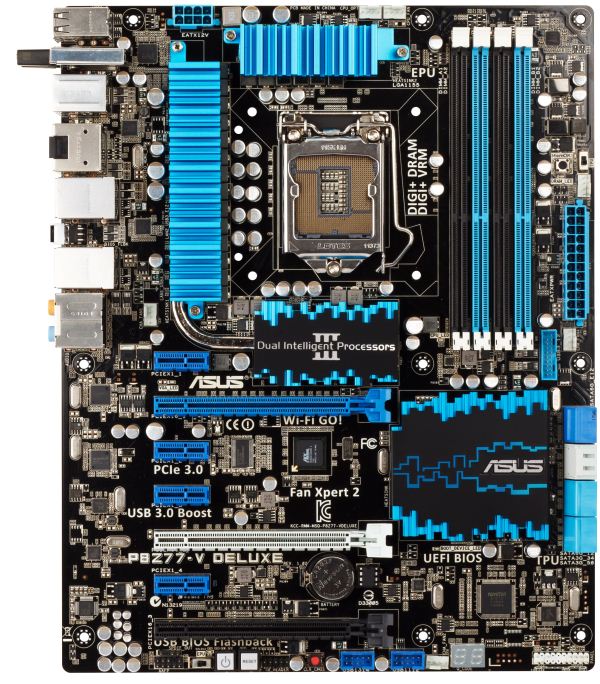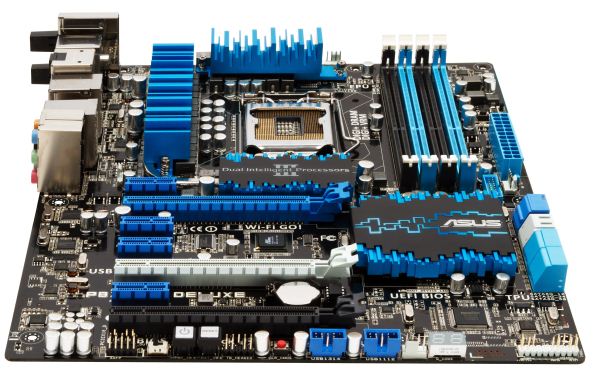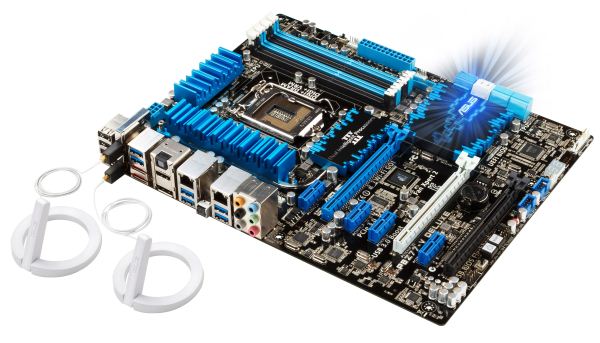Intel Z77 Panther Point Chipset and Motherboard Preview – ASRock, ASUS, Gigabyte, MSI, ECS and Biostar
by Ian Cutress on April 8, 2012 12:00 AM EST- Posted in
- Motherboards
- Intel
- Biostar
- MSI
- Gigabyte
- ASRock
- Asus
- Ivy Bridge
- ECS
- Z77
ASUS P8Z77-V Deluxe—Visual Inspection
In the next notch up in the channel board segregation, ASUS sell the Deluxe. This will be the first ASUS Deluxe board we have reviewed at AnandTech since the Llano mini-ITX F1A75-I Deluxe last year. In comparison to the P8Z77-V Pro, the Deluxe features several upgrades in terms of functionality and comfort.
The first to note is the increased power delivery to the CPU—this time in the form of a 16 + 4 phase power delivery. As a result, the VRM heatsinks to the left of the CPU are directly connected via a heatpipe to another heatsink below the socket. Also on board are the ‘enthusiast’ power/reset buttons and two-digit debug that we did not see on the Pro, and the use of dual NICs on the I/O, in the form of an Intel 82579V and a Realtek 8111F.
Due to the positioning off the heatsinks on the Deluxe compared to the Pro, the socket area seems a bit smaller (for example, the left hand heatsink is moved further in towards the socket), meaning that big air coolers may have a tougher time if they do not fit into Intel’s socket specification. Around the socket itself, we still have access to five fan headers—two 4-pin on the top of the board, one 4-pin to the bottom left of the main VRM heatsink, and one 4-pin either side of the 24-pin ATX power connector. A sixth fan header on board is found at the bottom next to the two-digit debug output.
Above the main power connector on the right hand side are the MemOK button and the TPU switch (for a fast automatic overclock). Below it is a USB 3.0 header, and a set of eight SATA ports. Similar to the ASUS Pro, we have four SATA 3 Gbps from the PCH, two SATA 6 Gbps also from the PCH, and two SATA 3 Gbps from a different controller—the Marvell 9128. This allows RAID 0/1 on these two SATA 6 Gbps ports.
The south side of the board still contains front panel headers and USB 2.0 ports, but also comes with the aforementioned power/reset buttons and two-digit debug display. We also find a ClearCMOS button on board, useful for overclockers. There is also a header labelled 'TB_Header', which should mean Thunderbolt, but there is no mention of it in the specifications. I will have to check up on this.
Update: The TB_Header is actually for a new Thunderbolt add-in card that ASUS will be selling. This is aimed to go into the x4 slot and provide Thunderbolt connectivity. MSRP will be around the $30-$40 mark so I am told.
In terms of the PCIe, we have a little bit of confusion. While in the middle between the PCIe is a PLX chip, it is not the PLX PXE 8747 chip that increases PCIe lane count. The one on the Deluxe is just to provide extra data transfer access for the various controllers on the motherboard. This means that the third full length PCIe in black is like other boards in that this is a PCIe 2.0 x4, non-GPU port. So from the top, we have a PCIe x1, x16 (x8 in Multi-GPU), x1, x1, x8, x1, x4. As a result, there is no PCIe to PCI bridge chip on this high-end model for PCI slots.
For the back panel, ASUS have done a juggling act deciding what to include. On the far left is a set of four USB 2.0 ports (black), a mini-PCIe WiFi + Bluetooth module, two USB 3.0 (blue), two eSATA, optical SPDIF output, HDMI output, DisplayPort, dual gigabit Ethernet, another four USB 3.0 ports (blue), a BIOS flashback button, and audio outputs. So in the name of a double NIC and 10 total USB ports on the back panel, we have lost D-Sub, DVI, IEEE1394 and a ClearCMOS button.
Board Features
| ASUS P8Z77-V Deluxe | |
| Size | ATX |
| CPU Interface | LGA-1155 |
| Chipset | Intel Z77 |
| Power Delivery | 16 + 4 |
| Memory Slots |
Four DDR3 DIMM slots supporting up to 32 GB Up to Dual Channel |
| Video Outputs | DisplayPort, HDMI |
| Onboard LAN |
Intel 82579V Realtek 8111F |
| Onboard Audio | Realtek ALC898 |
| Expansion Slots |
2 x PCIe x16 Gen3 (x16, x8/8) 1 x PCIe x16 Gen2 (x4) 4 x PCIe x1 Gen2 |
| Onboard SATA/RAID |
2 x SATA 6 Gbps (PCH), Support for RAID 0, 1, 5, 10 2 x SATA 6 Gbps (Marvell PCIe 9128), RAID 0, 1 4 x SATA 3 Gbps (PCH), Support for RAID 0, 1, 5, 10 2 x eSATA 6 Gbps (ASMedia) |
| USB |
Four USB 3.0 at rear (2 PCH, 2 ASMedia) Two USB 3.0 headers on board (PCH, ASMedia) Eight USB 2.0 (4 back panel, 4 on board) |
| Onboard |
4 x SATA 6 Gbps 4 x SATA 3 Gbps 1 x USB 3.0 Headers 2 x USB 2.0 Headers 6 x Fan Headers 1 x SPDIF Header 1 x Front Panel Audio Header 1 x TB Header MemOK! Button TPU/EPU Switches USB Flashback Button Power/Reset Buttons |
| Power Connectors |
1 x 24-pin ATX connector 1 x 8-pin 12V connector |
| Fan Headers |
1 x CPU Fan Header (4-pin) 4 x CHA Fan Headers 1 x OPT Fan Header |
| IO Panel |
2 x eSATA 6 Gbps 1 x DisplayPort 1 x HDMI 1.4a 2 x Gigabit Ethernet 6 x USB 3.0 4 x USB 2.0 1 x Optical SPDIF Audio Outputs Bluetooth V4.0 Wifi USB Flashback |
| Warranty Period | 3 Years |
| Product Page | Link |
Obviously one of the main selling points of the board is the onboard WiFi and Intel NIC (alongside a Realtek NIC).














145 Comments
View All Comments
ASUSTechMKT - Monday, April 9, 2012 - link
ASMedia does not produce or design a bluetooth controller. Additionally you are correct in that add in controllers do offer support for specialized modes of operation.functionality ( like charging )ASUSTechMKT - Monday, April 9, 2012 - link
the Intel controller under Windows 7 does not offer operating in UASP mode. With UASP the ASMedia add in controller can provide superior performance especially in queue depth. The USB3 Boost package is offered for both the Intel controller and the ASMedia ( Intel support change from BOT mode to SCSI ( Turbo mode ) and the ASMedia controller of support for BOT, SCSI ( Turbo ) as well UASP.MrMaestro - Sunday, April 8, 2012 - link
I didn't know a motherboard could be kitsch until I saw the ECS.XSCounter - Sunday, April 8, 2012 - link
P8Z77-M is the one I am waiting for for my Micro ATX build. It has no those xtra useless controllers which are all gonna be inferior to native Intel ones. So won't overpaying anything.However, I am planning to overclock so I wish to know how it will perform in this regard! Hoping to see these ASUS Micro ATX boards on Anandtech asap :)
http://uk.asus.com/Motherboards/Intel_Socket_1155/...
ASUSTechMKT - Monday, April 9, 2012 - link
It features a Digi+ VRM with robust VRM components overall in our testing the -M Pro provide comparable scaling to that of our standard board. You will see this information from ASUS soon. Solid board !Lonyo - Sunday, April 8, 2012 - link
What happened to the boards with 10 SATA ports?There were some from tradeshows earlier in the year, but none listed here (apart from the one with 8 + 2 eSATA).
Obviously this isn't a comprehensive lineup, but most of these seem to be fairly high end boards, yet no 10 SATA ports.
ASUSTechMKT - Monday, April 9, 2012 - link
Very few users use this many ports it makes sense more to prioritize expansion lane support to add ons that will be used. Keep in mind even with a board with that number of ports you may not actually be able to have that usable bandwidth.Should you really need that many you should consider an add on controller card. Things like SATA ports while important are not the only way to distinguish true attention to design in higher end boards.
aranyagag - Sunday, April 8, 2012 - link
"four SATA 6 Gbps also from the PCH," shouldn't that be sata 3 gbpsin the msi gd65 board
ConVuzius - Sunday, April 8, 2012 - link
The article says Virtu MVP has an i-Mode and a d-Mode, but which one is the better one? I kinda didnt get the difference, except where you connect your display.Ryan Smith - Sunday, April 8, 2012 - link
For regular Virtu, d-Mode is the mode that was better from a performance perspective, since at times performance under i-Mode dipped due to having to send frames out to the iGPU.For MVP, there's not going to be all that much of a difference. Regardless of the mode used Virtual V-Sync needs frames passed from the dGPU to the iGPU. The only difference is which display output is used, since a copy of the frame is on both GPUs (i.e. while you have to send frames to the iGPU, you don't have to send them back even in d-Mode).